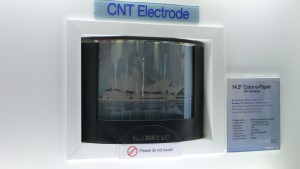Oct 16 2008
Unidym, Inc., a majority-owned subsidiary of Arrowhead Research Corporation, announced today that Samsung Electronics is demonstrating the world's first carbon nanotube-based color active matrix electrophoretic display (EPD) e-paper at the International Meeting on Information Display (iMiD) at KINTEX, Ilsan, Korea from October 13th through October 17th. The new color e-paper device is a 14.3" format display and is the result of an ongoing joint development program between Samsung Electronics Co., Ltd. and Unidym. The e-paper device uses a carbon nanotube (CNT) transparent electrode developed by Unidym.
 First color carbon nanotube-based electrophoretic display (Photo: Business Wire
First color carbon nanotube-based electrophoretic display (Photo: Business Wire
“Our ongoing successful collaboration with Samsung Electronics has delivered yet another world's first achievement this year,” said Arthur L. Swift, Unidym's president and CEO. “In May of this year Samsung demonstrated the world's first 2.3 inch black and white active matrix EPD made with carbon nanotubes, and now they have demonstrated the first color large scale EPD e-paper device, in an A4 format. This accomplishment marks a strong beginning to the second year of our joint development agreement to drive technology leadership between our companies in incorporating our carbon nanotube transparent electrodes into current display technologies.”
“This impressive accomplishment has been enabled by our continued improvement in important properties of our CNT films,” said Dr Paul Drzaic, CTO of Unidym. “To serve the various needs of the electronic display industry, our CNT materials need to demonstrate a number of key attributes: conductivity comparable to the incumbent ITO technology, uniformity over large areas in films, and compatibility with different display technologies and fabrication processes. This achievement between Samsung and Unidym demonstrates the applicability of Unidym's CNT films in electronic displays.”
EPD's offer inherent advantages over traditional flat panel displays due to their low power consumption and bright light readability, making them well suited for handheld and mobile applications. Since they can be produced on thin, flexible substrates, EPD's also are ideally suited for use in e-paper applications. Unlike conventional flat panel displays, EPD's rely on reflected light, and can retain text or images without constant refreshing, thereby dramatically reducing power consumption.